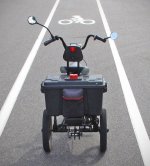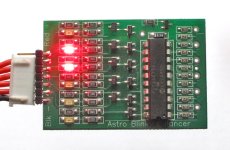eMark
100 kW
Charged my 10S3P pack and with trickle charge until it maintained 41.05 volts (1:00pm yesterday). Checked it again six hours later at 7:00pm, and still 41.05 volts. Checked it this morning at 9:00am (20 elapsed hours) with self-discharge of 0.01V (20.04 volts). Will check it once a month for self-discharge from mid-November to mid-March, but not done etriking yet with Bluebird nest boxes that need cleaning, any repairs, relocate, etc. Still have 135 miles before reaching 2,000 miles of etriking since last August (and it was stored for 4 months over the winter).
Did my third test run early this morning at a conservative pace. The first two test runs pulled an average of 8 to 10 amps until Controller cut-off. This third test run pulled my usual more conservative average of 4-5 amps until Controller cut-off. The photos are along the Luce Line State Trail (an old railroad bed most of the way) that I rode this morning to Wayzata for coffee and a blueberry bagel. The only steep incline was the bike lane bridge over highway (see photo). Used my own pedal power with a little motor assist in 3rd (pulled about 6-7 amps). If you guys ever come across a tombstone when you're a senior that reads, "Voltage Sag ... What's That ?" it may be my final resting place :wink:
Included a couple other photos taken along the Luce Line Trail (paved and gravel) this mornng. The guy at the bike station is changing the battery in his Pedal Power Watt Meter. On the way back i visited with another biker at that the same bike station. Still had 19 miles to go before reaching his destination. Asked him what he thought of a bike Power Meter and he said, "It wouldn't be of much use to me, i'm 77", but he sure didn't look it.
The other photo of the 4 cross country high school gals was early this morning on my way when it was only 57 degrees. Me ... wearing a sweater, light jacket and stocking cap. Minnesota girls are a hardy breed (probably hockey gals). Received four nice compliments on my etrike this morning. The gal at Caribou having seen me pull up out of her window said, "I need to get one" (and she meant it). Then a toddler being pushed in a stroller my his mom said, "cool" and another person said, "That is so neat!". And the fourth comment from a senior citizen when i was coming back at a faster clip (after changing to unitpackpower battery), "Look at that go!"
This time i changed to my backup unitpackpower battery after the first Controller cut-off at 32.25 volts. To my surprise the P-group variance (after checking once home) was higher at 53mV with just the first cut-off; whereas, my two previous test runs were lower (45mV and 41mV) after three and then two successive cut-offs which should have caused even more imbalance than stopping after the first Controller cut-off. The 53mV variance of my 10S3P was measured one hour after the Controller cut-off coming back while still on the Luce Line Trail.
Balance charging began after 1 1/2 hours rest from Controller cut-off. Bottom balance charging the two paralleled 5S3P packs at .5C (1.5 amps). After 10 minutes the ten P-group variance was down to 39mV, after 20 minutes 22mV, after 30 minutes 11mV. Then stopped to post this. Will conclude with some more data and summary of my balance charging Vruzend 10S3P 30Q 141 experimenting tomorrow and/or following day.
Hope you all are having a relaxing Labor Day :thumb:
Did my third test run early this morning at a conservative pace. The first two test runs pulled an average of 8 to 10 amps until Controller cut-off. This third test run pulled my usual more conservative average of 4-5 amps until Controller cut-off. The photos are along the Luce Line State Trail (an old railroad bed most of the way) that I rode this morning to Wayzata for coffee and a blueberry bagel. The only steep incline was the bike lane bridge over highway (see photo). Used my own pedal power with a little motor assist in 3rd (pulled about 6-7 amps). If you guys ever come across a tombstone when you're a senior that reads, "Voltage Sag ... What's That ?" it may be my final resting place :wink:
Included a couple other photos taken along the Luce Line Trail (paved and gravel) this mornng. The guy at the bike station is changing the battery in his Pedal Power Watt Meter. On the way back i visited with another biker at that the same bike station. Still had 19 miles to go before reaching his destination. Asked him what he thought of a bike Power Meter and he said, "It wouldn't be of much use to me, i'm 77", but he sure didn't look it.
The other photo of the 4 cross country high school gals was early this morning on my way when it was only 57 degrees. Me ... wearing a sweater, light jacket and stocking cap. Minnesota girls are a hardy breed (probably hockey gals). Received four nice compliments on my etrike this morning. The gal at Caribou having seen me pull up out of her window said, "I need to get one" (and she meant it). Then a toddler being pushed in a stroller my his mom said, "cool" and another person said, "That is so neat!". And the fourth comment from a senior citizen when i was coming back at a faster clip (after changing to unitpackpower battery), "Look at that go!"
This time i changed to my backup unitpackpower battery after the first Controller cut-off at 32.25 volts. To my surprise the P-group variance (after checking once home) was higher at 53mV with just the first cut-off; whereas, my two previous test runs were lower (45mV and 41mV) after three and then two successive cut-offs which should have caused even more imbalance than stopping after the first Controller cut-off. The 53mV variance of my 10S3P was measured one hour after the Controller cut-off coming back while still on the Luce Line Trail.
Balance charging began after 1 1/2 hours rest from Controller cut-off. Bottom balance charging the two paralleled 5S3P packs at .5C (1.5 amps). After 10 minutes the ten P-group variance was down to 39mV, after 20 minutes 22mV, after 30 minutes 11mV. Then stopped to post this. Will conclude with some more data and summary of my balance charging Vruzend 10S3P 30Q 141 experimenting tomorrow and/or following day.
Hope you all are having a relaxing Labor Day :thumb:



